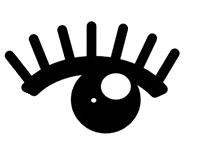MYOPIA and Treatment of Increasing Myopia in Children
Myopia, what is it?
Myopia is very common. It is a type of refractive error in which the eye cannot focus objects in the distance, and therefore makes things that are faraway look blurry. This is also called nearsighted, because near objects can be focused clearly.
With myopia, the eye is longer front to back than the normal eye, or the cornea (the clear window at the front of the eye) is curved too steeply.
During childhood, myopia is treated with glasses and/or contact lenses. Refractive surgery, such as LASIK or PRK, is a treatment option in adults once the glasses prescription is no longer changing.
Myopia is caused by both genetic and environmental factors. If either parent is near-sighted, the child is more likely to become near-sighted. Children who spend more time outdoors are less likely to develop myopia. Children who spend more time indoors doing near-focused activities, such as computer work, reading, and video games, tend to have higher rates of developing myopia.
As myopia increases, there is an increased chance of eye problems later, such as cataract, glaucoma, and retinal detachment. Due to these concerns, doctors are looking at ways to slow down the progression of myopia.
There are several steps a child can take every day to help slow myopia.
when looking at objects at near, hold the object more than 20cm from the eyes.
Use ample bright lights when reading.
Take breaks after 30 minutes of near activity and spend time outdoors during the breaks looking in the distance.
Spend more time outdoors (minimum 2 hours a day).
Limit screen time on computers and other digital devices.
There are many studies conducted on treatments to slow down the rate of increasing myopia. Currently the following are available:
Low dose atropine eye drops
Multiple large studies worldwide have shown that low dose atropine eye drops can slow the increase in myopia. Atropine eye drops are dilating eye drops that are commonly used for eye injuries, eye inflammation and to treat amblyopia in children. Commercially available atropine 1% dose is used for these problems. Recent research on lower doses of atropine 0.01% has consistently shown to be effective in decreasing the rate of increasing myopia, with fewer side effects than higher doses. (i.e., less or no light sensitivity and blurred near vision). The lower dose also has less of a rebound effect (significant increase or worsening myopia after the eye drop was stopped).
Treatment consists of low dose atropine 0.01% every day (at bedtime).
It is not known how it works exactly, but the thought is that drops may keep the eyes from lengthening.
Peripheral defocusing contact lenses
These are special multifocal contact lenses that are worn by children age 6 to 12 years of age with myopia. This lens looks like a dartboard, with multiple circles inside of each other. The center of the lens corrects the distance vison, while the outer portions blur the peripheral (side) vision. The blurring side vision is thought to slow eye growth and myopia progression.
MiSight contact lenses are the first FDA-approved contact lens for myopia control in the United States in 2019.
Like any contact lens, there is a risk of getting corneal ulcers or infections and scarring that can lead to permanent vision loss. It is important that the contact lens are worn correctly, cleaned and stored with sterile solution to avoid infection.
Orthokeratology (Ortho-K)
This is a hard contact lens that a child wears overnight to correct blurry vison during the day. The Ortho-K lenses flatten the cornea while worn asleep. The next day, the reshaped cornea focuses distant images clearly. The effect of vision improvement is short. Once you stop wearing the lenses the cornea slowly returns to its normal shape and the myopia comes back. It may provide some reduction in myopia progression.
There is a greater risk of corneal infection and scarring with Ortho-K lenses. They are also more difficult to fit compared to regular soft contact lenses. Thus, this option is less widely recommended.

